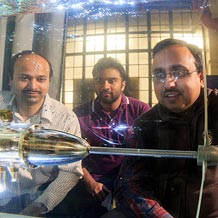Lehigh University
P.C. Rossin College of Engineering and Applied Science
Hydrokinetic Energy
The Energy Research Center is collaborating with the Turbulent Flow Design Group in the MEM Department on Marine and Hydrokinetic Energy (HKE) research and development. This group is under the direction of Prof. Arindam Banerjee. Other contributors include Profs. Alparslan Oztekin (MEM) and Panayiotis Diplas (CEE). Research focuses on energy conversion of tides and river and ocean currents into electricity. Specific activities include design, development and testing of hydrokinetic devices in the laboratory and open-water systems, and development of models and tools to support fundamental and applied studies, as well as optimization of hydrokinetic farms.
Laboratory facilities consist of water tunnel setup, equipped with an innovative turbulence generation system. Also available are state of the art fluid flow diagnostics (fast frame rate cameras, stereo particle imaging velocimetry) for detailed time-resolved (and volumetric) characterization of flow fields. The laboratory also houses several 12-core servers that run CFD programs, including ANSYS-CFX and OpenFOAM.
Sample of projects in HKE include:
Design Optimization of Marine Current Turbines - Focuses on the development, testing and validation of computational models and genetic algorithms to describe the non-linear dynamics of fluid-structure interactions (FSI) for HKE systems.
Study of Hydrodynamic and Hydrological Impacts of HKE Systems – Includes experimental studies of the three-way coupling between the hydrokinetic energy harvesting device, approach flow and local bed topography. The study also considers the overall impact of the energy harvesting device on river morphology (scour development), flood conveyance and sediment transport due to local extraction of kinetic energy from the stream and the induced non-homogeneous turbulent stream.
Hydrokinetic Farm Layout Configuration – Explores HKE arrays to quantify the effects of increased turbulence from various sources, including free-stream turbulence, upstream hydrokinetic devices (arrays) and in-stream structures like bridge piers, for optimal configurations. The work has been mostly supported through funding from Office of Naval Research.
Related Links:
- "Numerical investigation and evaluation of optimum hydrodynamic performance of a horizontal axis hydrokinetic turbine"
- "Performance characterization and placement of a marine hydrokinetic turbine in a tidal channel under boundary proximity and blockage effects"
- "A coupled hydro-structural design optimization for hydrokinetic turbines"
